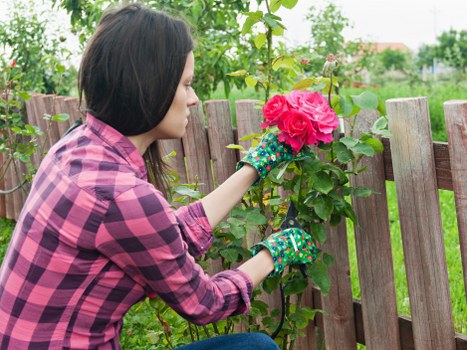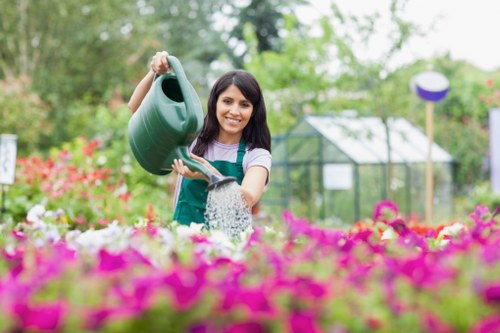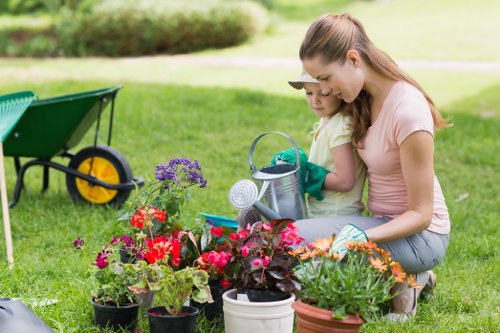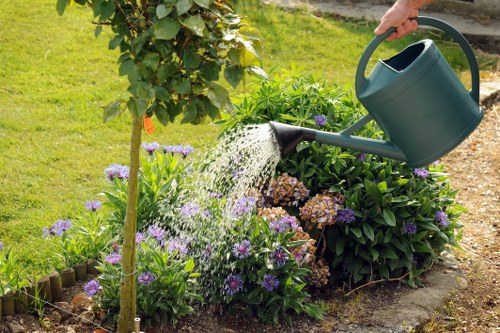Enhancing Your Space: Landscape Gardening in Marylebone
Introduction to Landscape Gardening in Marylebone

Marylebone, nestled in the heart of London, boasts a unique blend of urban charm and green serenity. **Landscape gardening** in this vibrant area is not just about planting flowers; it's about creating harmonious outdoor spaces that complement the local architecture and lifestyle.
Whether you're a seasoned gardener or a novice, understanding the nuances of landscape gardening in Marylebone can transform your outdoor area into a personal sanctuary. From selecting the right plants to implementing sustainable practices, every aspect plays a crucial role in achieving a picturesque garden.
In this comprehensive overview, we'll explore the key elements that make landscape gardening in Marylebone both rewarding and feasible, ensuring your garden thrives year-round.
Planning Your Garden Design

Assessing Your Space
Before diving into planting, it's essential to assess the available space. Marylebone gardens vary in size, from compact urban plots to expansive suburban yards. **Effective planning** ensures that every inch is utilized efficiently, balancing functionality with aesthetics.
Consider factors like sunlight exposure, soil quality, and existing structures. Mapping out these elements helps in determining the best layout, whether you prefer a formal garden, a relaxed cottage style, or a modern minimalist approach.
Additionally, think about the purpose of your garden. Do you want a space for entertaining, a personal retreat, or a vegetable garden? Clarifying your goals will guide your design decisions.
Creating a Layout
Once you've assessed your space, sketching a layout is the next step. Incorporate pathways, seating areas, and focal points such as water features or sculptures. **Strategic placement** of these elements can enhance the garden's flow and visual appeal.
Using design principles like symmetry, balance, and contrast can help in creating an aesthetically pleasing garden. Additionally, integrating different heights and textures adds depth and interest to your outdoor space.
Don't forget to leave room for growth. Plants will expand over time, so ensure there's adequate spacing to prevent overcrowding.
Choosing the Right Plants for Marylebone's Climate

Understanding the Local Climate
Marylebone experiences a temperate climate with mild winters and warm summers. Selecting plants that thrive in these conditions is crucial for a successful garden. Opt for species that are resilient to local weather patterns and soil types.
Deciduous trees like **holm oaks** and flowering shrubs such as **hydrangeas** are excellent choices. They offer seasonal interest and contribute to the overall biodiversity of your garden.
Perennial flowers like lavender, peonies, and hostas not only provide consistent blooms but also require less maintenance, making them ideal for busy urban gardeners.
Incorporating Native Plants
Incorporating native plants into your landscape design promotes sustainability and supports local wildlife. Native species are well-adapted to the environment, requiring less water and care.
Plants like **English bluebells**, **foxgloves**, and **Sedum** are native to the Marylebone area and add a touch of authenticity to your garden. They attract pollinators such as bees and butterflies, enhancing the ecological value of your outdoor space.
Additionally, native plants often have deeper root systems, which contribute to soil health and stability, making them a long-term investment for your garden.
Sustainable Gardening Practices

Water Conservation
In landscape gardening, **sustainability** is paramount. Implementing water conservation techniques not only benefits the environment but also reduces your maintenance efforts. Installing rainwater harvesting systems can provide a reliable water source during dry spells.
Using mulch around plants helps retain moisture, regulate soil temperature, and prevent weed growth. Additionally, selecting drought-resistant plants ensures your garden remains lush even with minimal watering.
Consider installing drip irrigation systems, which deliver water directly to the plant roots, minimizing waste and ensuring efficient hydration.
Composting and Soil Health
Healthy soil is the foundation of a thriving garden. **Composting** kitchen scraps and garden waste creates nutrient-rich compost, enhancing soil fertility and structure. Regularly amending your soil with compost improves drainage, aeration, and microbial activity.
Implementing crop rotation and avoiding overuse of chemical fertilizers also contribute to long-term soil health. Healthy soil supports robust plant growth and reduces susceptibility to pests and diseases.
Incorporate organic matter like leaf litter and green manure to maintain soil vitality and promote sustainable gardening practices.
Enhancing Your Garden with Hardscape Features

Pathways and Patio Areas
Hardscape elements like **pathways** and **patio areas** add structure and functionality to your garden. Pathways guide visitors through the space, highlighting key features and providing easy access to different sections.
Materials such as gravel, stone, and brick are popular choices that offer durability and aesthetic appeal. Designing meandering paths can create a sense of exploration, while straight lines provide a more formal look.
Patio areas serve as outdoor living spaces, perfect for entertaining or relaxing. Incorporating seating, fire pits, and outdoor lighting can enhance the usability and ambiance of these areas.
Water Features and Lighting
Adding **water features** like ponds, fountains, or waterfalls introduces a soothing element to your garden. The sound of flowing water can create a tranquil atmosphere and attract wildlife.
Strategic outdoor lighting not only highlights garden features but also ensures safety during evening hours. Solar-powered lights are an eco-friendly option that reduces energy consumption.
Consider accent lighting for pathways and focal points to add depth and dimension to your landscape design.
Seasonal Garden Maintenance Tips
Spring Preparation
Spring is the perfect time to rejuvenate your garden. Begin by clearing debris, pruning dead branches, and preparing beds for new plantings. **Mulching** in spring helps retain soil moisture and suppresses weed growth.
Planting early spring flowers like tulips and daffodils can add vibrant colors as the garden awakens from winter. Additionally, fertilizing plants prepares them for the growing season ahead.
Regular watering and monitoring for pests ensure that your garden starts the year strong.
Summer Care
During the summer months, maintaining adequate moisture levels is essential. Regular watering, especially during dry spells, keeps plants healthy and vibrant.
Pruning and deadheading flowers encourage continuous blooming and prevent overgrowth. Implementing shading techniques for delicate plants can protect them from excessive heat.
Monitor for pests and diseases, addressing issues promptly to maintain the garden's integrity.
Autumn and Winter Maintenance
As autumn approaches, preparing your garden for the cooler months is crucial. Clearing fallen leaves, cutting back perennials, and protecting sensitive plants help ensure their survival through winter.
Applying a thick layer of mulch provides insulation against frost and temperature fluctuations. Additionally, storing garden tools and furniture properly extends their lifespan.
Consider planting bare-root trees and shrubs in autumn to give them a head start for the next growing season.
Hiring Professional Landscape Gardeners in Marylebone
Benefits of Professional Services
While DIY gardening can be fulfilling, hiring professional **landscape gardeners** in Marylebone offers numerous advantages. Professionals bring expertise, experience, and a keen eye for design, ensuring your garden meets both aesthetic and functional goals.
They can provide tailored solutions based on your garden's specific needs, climate considerations, and your personal preferences. From initial design to maintenance, their services encompass all aspects of landscape gardening.
Moreover, professionals have access to high-quality materials and plants, enhancing the overall quality and longevity of your garden.
Choosing the Right Gardener
Selecting the right landscape gardener is essential for achieving the desired results. Look for experienced professionals with a solid portfolio and positive client reviews. **Local expertise** is beneficial, as they understand Marylebone's climate, soil conditions, and design trends.
Discuss your vision and requirements clearly, ensuring they align with the gardener's capabilities. Transparent communication and a clear contract outline safeguard both parties and set expectations.
Don't hesitate to ask for references or visit past projects to gauge the quality of their work.
Cost Considerations
While hiring professionals involves an investment, it's important to consider the long-term benefits. Quality workmanship and well-chosen materials can save you money on repairs and replacements in the future.
Obtain detailed quotes and compare services to ensure you're getting value for your money. Remember that the cheapest option isn't always the best; prioritize quality and reliability.
Some gardeners offer flexible payment plans or packages, making professional services more accessible.
Communities and Resources for Gardeners in Marylebone
Local Gardening Groups
Joining local **gardening groups** can provide valuable support and inspiration. Marylebone boasts a vibrant community of garden enthusiasts who share tips, organize events, and collaborate on projects.
Participating in these groups fosters a sense of camaraderie and offers opportunities to learn from experienced gardeners. Workshops, plant swaps, and garden tours are common activities that enrich your gardening journey.
Engaging with the community can also keep you updated on local gardening trends and resources.
Access to Resources
Marylebone offers a wealth of resources for landscape gardeners. Local nurseries provide a wide selection of plants suited to the area's climate, while garden centers offer essential tools and supplies.
Libraries and online platforms host a plethora of information on gardening techniques, design ideas, and plant care. Utilizing these resources can enhance your knowledge and skills, leading to a more successful garden.
Additionally, local government initiatives often support urban gardening projects, providing grants or spaces for community gardens.
- Attend local gardening workshops
- Visit nearby nurseries for plant selection
- Participate in community garden projects
- Utilize online gardening forums and resources
- Stay informed about local gardening events
Educational Opportunities
Continuous learning is key to successful landscape gardening. Marylebone residents have access to various educational opportunities, including classes, seminars, and online courses.
These programs cover a range of topics from basic gardening skills to advanced landscape design principles. Investing time in education can greatly improve your gardening proficiency and inspire innovative ideas for your outdoor space.
Moreover, collaborating with experts through these platforms provides insights that can elevate the quality of your garden.
Conclusion

Landscape gardening in Marylebone offers a unique opportunity to blend urban living with natural beauty. **Thoughtful planning**, sustainable practices, and a keen eye for design are essential components of a thriving garden.
Whether you choose to embark on this journey solo or enlist the help of professional gardeners, the rewards are immense. A well-crafted garden not only enhances your property's aesthetic appeal but also provides a personal retreat amidst the bustle of city life.
Ready to transform your outdoor space? Contact us today to start your landscape gardening journey in Marylebone, and turn your garden dreams into reality.

